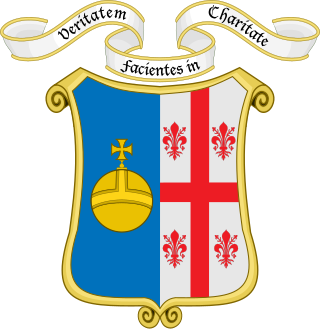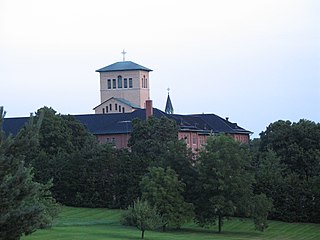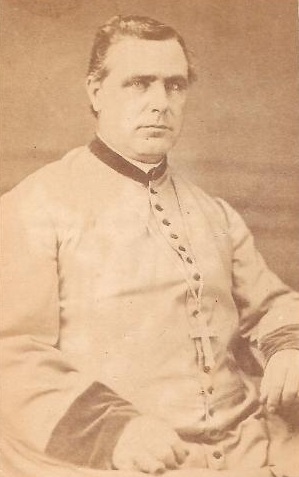Related Research Articles
The Franciscan Sisters of Christian Charity are a Congregation of Roman Catholic apostolic religious women. The congregation was founded in 1869 in Manitowoc, Wisconsin in the Roman Catholic Archdiocese of Milwaukee, later part of the Roman Catholic Diocese of Green Bay. The sisters have active apostolates in education, health care, spiritual direction, and other community ministries. As of 2021, there are 188 sisters in the community. The FSCC is a member of the Council of Major Superiors of Women Religious, an organization which represents women religious in the United States.

The Missionaries of the Precious Blood is a Catholic community of priests and brothers. The society was founded by Saint Gaspar del Bufalo in 1815.

The Sisters of St. Joseph, also known as the Congregation of the Sisters of St. Joseph, abbreviated CSJ or SSJ, is a Roman Catholic religious congregation of women founded in Le Puy-en-Velay, France, in 1650. This congregation, named for Saint Joseph, has approximately 14,000 members worldwide: about 7,000 in the United States; 2,000 in France; and are active in 50 other countries.

The Institute of Christ the King Sovereign Priest, Latin: Institutum Christi Regis Summi Sacerdotis, abbreviated as ICRSS and ICKSP, is a society of apostolic life of pontifical right in communion with the Holy See of the Catholic Church. The institute has the stated goal of honouring God and the sanctification of priests in the service of the Catholic Church and souls. An integral part of the institute's charism is the use of the traditional liturgy, namely the Missal of John XXIII for Mass, the Breviary of John XXIII for the Divine Office, and the Rituale Romanum for other sacraments. The society has undertaken the restoration of a number of historic church buildings.

The Benedictine Sisters of Perpetual Adoration are a congregation of sisters that follow the Rule of St. Benedict and practice daily Eucharistic adoration. Their monastery is located in Clyde, Missouri.
The Third Order of Saint Francis is a third order in the Franciscan tradition of Christianity, founded by the medieval Italian Catholic friar Francis of Assisi.

The Oblate Sisters of Providence (OSP) is a Catholic women's religious institute founded by Mother Mary Elizabeth Lange, and James Nicholas Joubert in 1829 in Baltimore, Maryland for the education of girls of African descent. It was the first permanent community of Black Catholic sisters in the United States.
The Sisters Adorers of the Precious Blood are a contemplative and cloistered religious institute of the Catholic Church. They were founded in 1861 by Catherine Aurelia Caouette in Saint-Hyacinthe, Quebec, Canada.

The Roman Catholic Diocese of Saint-Hyacinthe is a Latin rite suffragan of the Metropolitan Archdiocese of Sherbrooke in Quebec, Canada.

The Congregation of Divine Providence is a Catholic religious institute of women that was founded in 1851 in the Grand Duchy of Hesse by Wilhelm Emmanuel von Ketteler, Bishop of Mainz, together with Stephanie Fredericke Amalie de la Roche von Starkenfels (1812–1857), a French noblewoman. The congregation was formally recognized by the Holy See on 16 July 1935.
Jeanne Fontbonne, more commonly known by her name in religion Mother St. John Fontbonne, was a French religious sister. She founded the Congregation of the Sisters of St. Joseph of Lyon in 1808 and served as its first Superior General.

Joseph Gregory Dwenger, C.P.P.S was an American prelate of the Catholic Church. He served as Bishop of Fort Wayne from 1872 to 1893.
Congregations of the Precious Blood can refer to:
Sisters of the Precious Blood may refer to:

The Sisters of the Precious Blood is a Catholic religious order for women founded in Grisons, Switzerland, in 1834 by Mother Maria Anna Brunner. Precious Blood Sisters form an active apostolic congregation with sisters currently serving in the United States, Chile, and Guatemala.
When referring to Roman Catholic religious orders, the term Second Order refers to those communities of contemplative cloistered nuns which are a part of the religious orders that developed in the Middle Ages.

The Dominican Congregation of the Most Holy Name of Jesus, better known as the Dominican Sisters of San Rafael, is an institute of religious sisters belonging to the Third Order of St. Dominic founded in California in 1850 to teach the children of the new American territory. They also operate health facilities. They are located in San Rafael, California.

St. Mary's Institute of O'Fallon, also known as the Motherhouse for the Congregation of the Sisters of the Adoration of the Most Precious Blood, is a historic convent, school, and national historic district located at O'Fallon, St. Charles County, Missouri. The district encompasses 11 contributing buildings and 1 contributing site. The main building is the three-story, Gothic Revival style motherhouse. Its original section was built in 1874, with a series of interconnected wings dating from 1874 through 1997 making for a complex, irregular plan building. The building includes the convent, two chapels, academy, novitiate, dining room, kitchen, gym, and infirmary. A part of the building houses the O'Fallon City Hall.
The Sisters of the Society of Saint Pius X are a semi-contemplative order of religious sisters founded by Archbishop Marcel Lefebvre on September 22, 1974. The motherhouse is located in Saint-Michel-en-Brenne, France, with additional houses in Argentina, Australia, Belgium, Germany, Italy, Switzerland and the United States. As of 2018, the current Superior General is Mother Maria Jean Bréant.
References
- ↑ Payne CPPS, Barbara. "Foundations in Steinerberg, Switzerland", Sisters of the Most Precious Blood of O’Fallon, Missouri
- ↑ Müller, Ulrich, Aimée de Marie, and Mary Victoria. "Congregations of the Precious Blood." The Catholic Encyclopedia Vol. 12. New York: Robert Appleton Company, 1911. 31 July 2019
 This article incorporates text from this source, which is in the public domain .
This article incorporates text from this source, which is in the public domain . - 1 2 3 4 The Catholic Church in the United States of America, Catholic Editing Company, 1914, p. 424
 This article incorporates text from this source, which is in the public domain .
This article incorporates text from this source, which is in the public domain . - ↑ "Parish history". www.polishchurchstlouis.org. Retrieved 27 December 2023.
- ↑ Brinker, Jennifer. "From Switzerland to O’Fallon: Sisters of the Most Precious Blood continue charism of bringing Jesus’ reconciling presence to the world", St. Louis Review, September 16, 2019
- ↑ Adorers of the Blood of Christ
![]() This article incorporates text from a publication now in the public domain : Herbermann, Charles, ed. (1913). "Congregations of the Precious Blood". Catholic Encyclopedia . New York: Robert Appleton Company.
This article incorporates text from a publication now in the public domain : Herbermann, Charles, ed. (1913). "Congregations of the Precious Blood". Catholic Encyclopedia . New York: Robert Appleton Company.